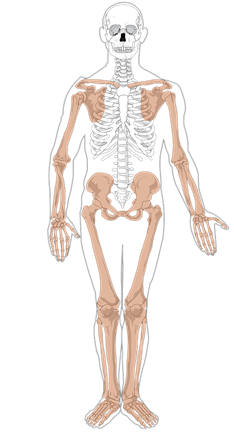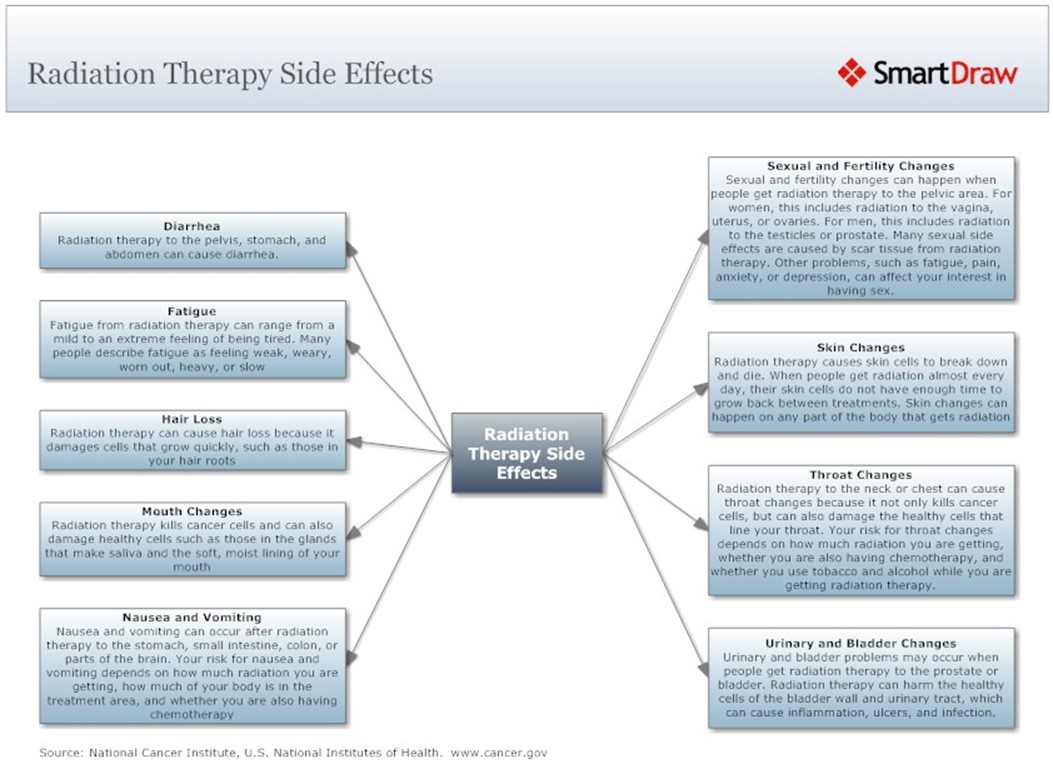Skeletal Deterioration from Radiation
Back to Jesicha's Hope
Back to categories:
September 9, 2016
 Bone
loss causes more spontaneous fractures in men and women alike that are
being treated for cancer. So what is bone loss exactly? It is a
disruption in the normal remodeling activity, with an increase in the
breakdown of bone without replacement rebuilding. Normally bone is
constantly being broken down and rebuilt, we tend to recycle bone mass
each week at a rate of 5 to 7 percent. When this does not occur due to
osteoporosis, hormone therapy in the treating of breast or prostate
cancers, chemotherapy, bone cancer, bone metastases, bisphosphonate
drugs, and radiation exposure or therapeutic treatment of cancer; bone
loss is the resulting consequence.
Bone
loss causes more spontaneous fractures in men and women alike that are
being treated for cancer. So what is bone loss exactly? It is a
disruption in the normal remodeling activity, with an increase in the
breakdown of bone without replacement rebuilding. Normally bone is
constantly being broken down and rebuilt, we tend to recycle bone mass
each week at a rate of 5 to 7 percent. When this does not occur due to
osteoporosis, hormone therapy in the treating of breast or prostate
cancers, chemotherapy, bone cancer, bone metastases, bisphosphonate
drugs, and radiation exposure or therapeutic treatment of cancer; bone
loss is the resulting consequence.
Cancer patients, most especially breast and prostate cancer patients are given what is known as bisphosphonate drugs. These are FDA-approved to strengthen bones due to damage that has or will occur through the use of cancer treatments [chemotherapy and radiation]. Whilst the FDA approves of these drugs for that purpose there is strong evidence they actually create a reaction in the bones to allow spontaneous fractures. Experts believe prolonged use of bisphosphonates suppresses the remodeling and forms an insufficiency fracture of the femur, though they do not know at the point of the study whether all bisphosphonates drugs produced will have a similar effect on patients; yet patients are warned extended use puts them at risk. A Japanese study points out the characteristics of atypical fractures of the femur through the mechanisms of how bisphosphonates weaken bone structure. The mechanism of bisphosphonates reduces bone turnover by altering bone minerals and its matrix, causing an increase in advanced glycation end products of the extracellular bone matrix, thus deteriorating the mechanical properties of the bone. Extended use causes an accumulation of micro-damage to the bone reducing the heterogeneity of the bone's organic matrix and minerals. Simply put, bisphosphonate drugs suppress the natural production of new bone growth by substituting an artificial matrix that creates a brittle bone prone to fractures, many of which are spontaneous.
It is widely known that radiation causes bone damage as does chemotherapy. Using a drug that will further cause bone damage is not the wisest decision yet without patients understanding the mechanisms by which bisphosphonates work and how they will create brittle bones, patients have no method of discovery. To save your bones from damage, bisphosphonates are not the answer.
Radiation – one of the most common methods to treat cancer, often combined with chemotherapy drugs. But is radiation safe? Will it affect your bones? The is yes.
Radiation therapy is delivered to a specific area to treat a disease, usually cancer. They try to kill off rapidly dividing cells, it is usually used with surgery and/or chemotherapy and study will often remark it is difficult to separate the effects of chemo from the effects of radiation. However, there is enough evidence shown when chemotherapy is not used that radiation can have detrimental effects on the bones as well other side effects.
X-rays, gamma rays, and other ionizing radiation are offered as effective cancer treatments. Radiation therapy uses a much higher dose of radiation than typical imaging tests, they are in-therapy treatments aiming to kill cancer cells through high doses directly hitting the targeted cells. DNA mutations can occur in surviving cells, which can lead to secondary cancer. Short-term side effects can include skin changes, nausea, vomiting, and low blood counts. Long-term effects vary as well; one major effect is bone weakness. It is also noted infertility is a common side effect for both male and female patients.
Rad, Gray, Rem, Sievert, what do they mean and how do they affect the human body? They are methods of measurement for radiation exposure. Rad and Gray are absorb dose units. Rem and Sievert measure the biological damage to the human body. Depending on the photons per second given Rads or Grays deposit a higher energy deposition in tissue or at a lower rate less deposition. For example, a rad or Gray of alpha energy absorbed by soft human tissue does 20 times more damage than a rad or Gray of gamma, x-ray or beta energy absorbed. It is not necessary to fully understand the conversion of Rads to Rems or Grays to Sieverts but understanding little will go a long way in understanding the damaging effects to the human body.
The amount of radiation or the dose varies depending on the test or treatment. Imaging exposure gives you about a 0.1 mSV [milli Sievert] for a 2 view chest x-ray while a regular chest x-ray is about 7-8 mSV. A PET /CT scan can be as high as 30mSV. Often the settings are not changed from adults to children, giving children a higher exposure. For example, a stomach scan may expose the adult to 10 mSV yet the same setting would expose a baby to 20mSV.
Typically, a person will be exposed through ambient radioactivity, dental x-rays, airport scanners, and such radiation to about 2- 3 millisieverts. The annual exposure in the US for nuclear plant workers is 0.05 Sieverts, below these levels, the DNA repairing is kept up without damage to the body. Above this level and the body cannot keep up with the damage. 100 millisieverts is where cancer risk begins.
What is occurring in the body when the levels of radiation are far higher than what the government allows nuclear plant workers as a safe level? Bone loss or damage, and a vast list of other side effects:
Nausea and vomiting, epithelial surface damage, mouth, throat, and stomach sores, intestinal discomfort, swelling, infertility, fibrosis, hair loss, salivary gland and tear duct dryness, sweat gland loss of function, lymphedema, secondary cancer, heart disease, cognitive decline, damage to the GI tract, pituitary issues, pelvic bone changes and weakening of the bones.
While most of the side effects are recognized and some dealt with, others are pushed off and often not considered or accepted as an effect of radiation treatments. The most damaging for the quality of life and sometimes life itself is the damage to the bone structure. Our skeletal system is our framework, without it, we are unable to fully function, enjoy life or live with any true quality of life.
2 Grays of radiation given to a human is about a normal dose of a single radiation treatment, a full dose delivers typically as much as 70 to 80 Grays. Bone loss was known in patients that had full doses but studies show that even a single dose can trigger severe bone loss, coupled with chemotherapy and the patient receives a double hit to their bones. There is a cumulative effect and this greatly increases the damaging effects. Bone health was adversely affected in bone density, thickness, spacing, and trabecular connectivity.
In a study done by James Ewing, MD [ 1866-1943] American pathologist, using radiation to shrink bone tumors, with surgery and Coley's toxins, three patients studied were described that their irradiated bones became brittle and easily fractured. Ewing noted he observed a thickening in the outer layer of the bone at the expense of the marrow cavity, as well as susceptibility to infection.
Peter Dedon [ Radiation Protection Committee at MIT, member] said: "What happens is that the nucleus of radioactive elements undergoes decay and emits high-energy particles. If you stand in the way of those particles, they are going to interact with the cells of your body. You literally get a particle, an energy packet, moving through your cells and tissues."
Note: no mention of bone loss in the above chart
Exposing bone to radiation may result in major complications, necrosis [cell death], fractures, severe changes in bone growth, and secondary radiation-induced cancer. The tolerance dose for an adult femur is 38 to 43 Grays. The chart describing dosages of radiation says 20,000 mSV or 20 Grays is a targeted dose for cancer radiotherapy. Yet, typically, 80,000 mSV or 80 Grays is used as a dosage for prostate cancer, 60,000 mSV or 60 Grays for breast cancer, 70,000 mSV or 70 Grays for lung cancer, with rectal cancer at 50,000 mSV or 50 Grays. Remember, 2-3 mSV are considered safe. And over 100 mSV is cause for risk of secondary cancer. It is also cumulative.
The incidence of osteoradionecrosis or bone death by radiation at 70 – 80 Grays is at about 14-22 percent. When the femur, for example, can tolerate about 38- 43 Grays it is obvious why the incidence of bone loss is so greatly found in patients exposed to radiotherapy.
Pelvic bone exposure leads to hip and pelvic bone problems including weak bones and cracks in the bone. Often bone cells are damaged so they are unable to function properly, therefore, they cannot supply the bones with proper nutrients, this leads to weak bones or blood loss that occurs from damage avascular necrosis. Tiny cracks can appear in pelvic bones called pelvic insufficiency fractures. Those that are older or also take hormone treatments will be at a greater risk
Bone density is decreased, and osteoradionecrosis [bone death from radiation] of the mandible, pelvis, hip, long bones [ as in the legs] and ribs are the most common bone damage from radiation. In children, long bones and the spine may mature abnormally if the damage is in the growth plate. In the Journal of the American Medical Association [JAMA], it was noted in an article that 60- 200 percent increase in hip fracture rates following radiotherapy for pelvic cancer in women, of those breaking a hip the decline in quality of life may lead to death in approximately 20 percent of those cases affected.
According to Ted Bateman, professor, and director of Clemson's Osteoporosis Biomechanics Laboratory, "Past studies confirm that patients who are undergoing radiation treatment for cancer experience more fractures and hip fractures are particularly damaging to long-term health."
So, pain results and quality of life suffers, doctors will suggest pain killers, bisphosphates [that we know will further run the risk of weakening the bones], and walking aids like a cane or walker. Hip replacement, rods, and screws put in place by an orthopedic surgeon may be suggested. Is this a solution? Weighing in the benefits to the negative side effects, how does radiation rank?
How do we face cancer patients and tell them radiation is a good choice? What do we tell patients that have bone damage from radiation or chemotherapy? Do we give them methods to help rebuild their skeletal system? I think that is a step in the right direction. Is an alternative to invasive and damaging radiation treatment in order? And there is.
Do you need to discuss alternative options to radiation? Have you had damage and what to try to repair your bones? Ask someone at Jesicha's Hope to help you. Contact us at www.jesichashope.org or email us at info@jesichashope.org visit our Facebook page: www.facebook.com/jesichashope or join a discussion in our group www.facebook.com/groups/alternativecancertreatments
References:
http://www.rense.com/general74/cattn.htm
http://www.popsci.com/science/article/2011-03/fyi-how-does-nuclear-radiation-do-its-damage
http://www.informationisbeautiful.net/visualizations/radiation-dosage-chart/
http://www.naturalnews.com/032136_radiation_exposure_chart.html
https://en.wikipedia.org/wiki/Radiation_therapy
http://www.radprocalculator.com/FAQ.aspx
http://www.cancer.org/acs/groups/cid/documents/webcontent/acspc-038756-pdf.pdf
http://www.physio-pedia.com/Radiation_Side_Effects_and_Syndromes
http://bjmp.org/content/bisphosphonates-and-atypical-femur-fractures
http://www.texasoncology.com/types-of-cancer/bone-cancer/bone-loss
http://www.ncbi.nlm.nih.gov/pmc/articles/PMC4480549/
